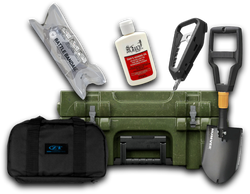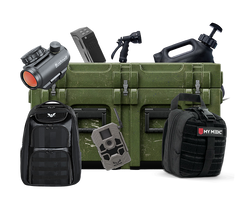What is a Light Machine Gun? Understanding the Role, Features, and Evolution
Table of Contents
- Introduction
- Defining the Light Machine Gun
- Historical Context
- The Role of Light Machine Guns in Modern Warfare
- Notable Examples of Light Machine Guns
- Conclusion
- FAQ
Introduction
Imagine a battlefield where the air is thick with tension, and soldiers must rely on their weapons to protect themselves and advance against the enemy. In such scenarios, the importance of effective firepower cannot be overstated. One of the pivotal weapons that has shaped modern warfare is the light machine gun (LMG). This weapon is not just a tool; it represents tactical evolution and strategic advantage in infantry operations.
Light machine guns are designed to provide suppressive fire, allowing infantry units to maneuver effectively while keeping the enemy pinned down. As we delve into the intricacies of what a light machine gun is, we’ll explore its characteristics, operational history, and significance on the battlefield. Whether you’re a tactical enthusiast, an aspiring survivalist, or simply curious about military gear, understanding the LMG will enhance your knowledge of modern firearms and their applications.
In this comprehensive guide, we will clarify the definition of a light machine gun, dissect its key features, analyze its evolution, and discuss its role in contemporary military operations. By the end of this post, you will have a detailed understanding of LMGs and why they are essential in tactical and survival scenarios.
Defining the Light Machine Gun
A light machine gun is a lightweight, fully automatic firearm designed to be operated by a single soldier. Unlike heavier machine guns that require a crew to operate, LMGs can be handled by an individual, making them an integral part of infantry tactics. They are specifically engineered to provide sustained fire support, allowing troops to maintain a continuous rate of fire while advancing or defending positions.
Key Features of Light Machine Guns
-
Weight and Portability
LMGs are designed to be lighter than their medium and heavy counterparts, allowing for easier carrying and deployment in various combat situations. This portability is crucial as it enables soldiers to move quickly while still having effective firepower. -
Firing Mechanism
Most LMGs utilize a gas-operated or recoil-operated mechanism, allowing them to fire multiple rounds with minimal effort from the operator. This mechanism is key to their functionality in suppressive fire roles. -
Ammunition Feed
Light machine guns typically employ either belt-fed or magazine-fed systems. The belt-fed design allows for a larger ammunition capacity, which is essential for sustained fire during critical moments. Some LMGs can also accept standard rifle magazines as a backup, enhancing their versatility in the field. -
Bipod Support
To stabilize the weapon during firing, most LMGs are equipped with a bipod. This feature allows for improved accuracy, especially during sustained fire. The ability to set the weapon up for prone firing significantly enhances its effectiveness on the battlefield. -
Caliber and Fire Rate
Light machine guns generally fire the same caliber ammunition as the standard infantry rifle, making logistical support simpler. Their fire rates can vary, but they are designed to achieve a high volume of fire, often exceeding 600 rounds per minute.
Distinctions from Other Firearms
While LMGs share some similarities with automatic rifles and general-purpose machine guns, they are distinct in their intended use and operational capacity. Automatic rifles are typically designed for individual use and may not sustain fire as effectively as an LMG, which is optimized for prolonged engagement. Conversely, general-purpose machine guns can be configured for both light and medium roles, but LMGs are specifically designed for infantry support.
Historical Context
The concept of the light machine gun emerged during the early 20th century as military theorists recognized the limitations of existing heavy machine guns in infantry assaults. In 1903, French military leaders advocated for a more mobile solution that could accompany advancing troops, culminating in the development of the LMG. The term "marching fire" was coined to describe the tactic of using suppressive fire to enable infantry movements.
Evolution Through the Wars
-
World War I
The first practical LMGs were deployed during World War I, where their ability to provide continuous fire support became evident. The French Chauchat and the British Lewis gun played pivotal roles, enabling infantry to break through enemy lines. -
World War II
By World War II, LMGs became standard issue in most armies. Models like the Browning Automatic Rifle (BAR) and the Bren gun were widely used, demonstrating the effectiveness of LMGs in providing suppressive fire and supporting assault tactics. -
Post-War Developments
The Cold War era saw advancements in LMG design, with the introduction of more lightweight materials and modern ammunition systems. The FN Minimi and the M249 SAW became iconic representations of LMGs, serving various military forces around the globe.
The Role of Light Machine Guns in Modern Warfare
In today’s military landscape, light machine guns continue to play a vital role in infantry operations. Their design allows for flexibility and adaptability, making them suitable for a variety of combat scenarios.
Tactical Applications
-
Suppressive Fire
One of the primary roles of an LMG is to provide suppressive fire. This capability allows infantry units to move under cover while keeping the enemy engaged, reducing the likelihood of counterattacks. -
Assault Support
LMGs are often used to support assaults on fortified positions. By delivering a high volume of fire, they can disrupt enemy defenses, allowing assaulting troops to advance more effectively. -
Defensive Operations
In defensive scenarios, LMGs are positioned to cover critical areas, providing a steady stream of fire to deter enemy advances. Their ability to fire from various positions, including prone, makes them adaptable in a defensive stance.
Integration with Infantry Units
The integration of LMGs into infantry units has evolved significantly. Modern military doctrine emphasizes the importance of fire teams equipped with LMGs to enhance overall combat effectiveness. The squad-level deployment of LMGs ensures that every team has access to suppressive fire capabilities, enhancing operational success.
Notable Examples of Light Machine Guns
Several iconic light machine guns have made their mark in military history. Each of these models showcases unique features and capabilities that have influenced modern designs.
-
Browning Automatic Rifle (BAR)
Developed during World War I, the BAR was one of the first widely used LMGs. Its ability to deliver sustained fire made it a favorite among infantry soldiers, and it continued to see service in various conflicts. -
Bren Gun
A British LMG that became synonymous with World War II, the Bren gun was known for its reliability and accuracy. Its distinctive top-mounted magazine and bipod made it a formidable weapon on the battlefield. -
FN Minimi
This Belgian-designed LMG is widely used by NATO forces. The Minimi is celebrated for its modularity and ease of use, capable of firing both from a belt and magazine, which enhances its adaptability in various combat situations. -
M249 Squad Automatic Weapon (SAW)
The M249 has been a staple of the U.S. military since the 1980s. With its lightweight design and high rate of fire, it serves as an essential component of infantry fire teams, providing suppressive fire and support during engagements.
Conclusion
Understanding what a light machine gun is involves appreciating its significance in military history, its tactical applications, and its evolution over time. LMGs serve as a critical component in modern infantry operations, allowing soldiers to maintain suppressive fire while maneuvering on the battlefield. As technology continues to advance, the design and use of light machine guns are likely to evolve further, reflecting the changing nature of warfare.
As tactical enthusiasts, survivalists, and community members, it’s essential to appreciate the role of these weapons in enhancing preparedness and operational effectiveness. The knowledge of LMGs not only enriches our understanding of military tactics but also empowers us in discussions about gear, strategy, and survival scenarios.
If you are looking to enhance your preparedness with high-quality tactical gear, consider exploring Crate Club's subscription services. With curated tactical gear delivered monthly, you can stay equipped for any situation. Check out their subscription services and explore the Crate Club Shop for the best in tactical and survival gear.
FAQ
What is the primary purpose of a light machine gun?
The primary purpose of a light machine gun is to provide suppressive fire to support infantry movements, allowing troops to advance while keeping the enemy engaged.
How does a light machine gun differ from a heavy machine gun?
Light machine guns are designed for individual use and are lighter and more portable than heavy machine guns, which typically require a crew and are used for sustained fire from a fixed position.
What types of ammunition do light machine guns use?
Light machine guns usually fire the same caliber ammunition as standard infantry rifles, which simplifies logistics and ensures compatibility within units.
Can light machine guns be used in defensive operations?
Yes, light machine guns are commonly used in defensive operations to cover critical areas and deter enemy advances with sustained fire.
What are some modern examples of light machine guns?
Notable modern examples include the FN Minimi and the M249 Squad Automatic Weapon (SAW), both of which are widely used by military forces around the world.
Comparte este artículo



